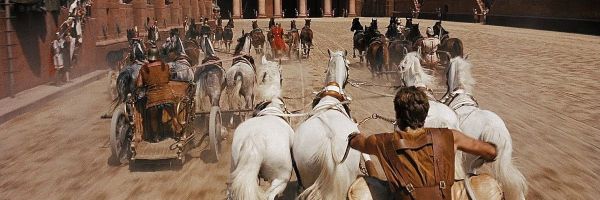
The old adage “they don’t make ‘em like they used to” applies more aptly to 1959’s Ben-Hur than almost any film of its era. An epic on a scale never before seen, it survives now like a Hollywood time capsule. Watching it through modern eyes is a constant reminder of a bygone period of filmmaking. Today marks sixty years since William Wyler’s larger than life picture hit theaters. Made on an enormous budget then—$15 million—the movie was a tremendous hit, despite a runtime of about three and a half hours. For millennials and Gen Z-ers, Ben-Hur is a movie for their grandparents. The world has moved on, after all; no need to go back and consume such antiquated art. One can’t help but wonder, in 2019, what about this movie so appealed to audiences then, and why studios haven’t bothered developing anything of its ilk in eons.
It was the penultimate month of the 1950s when Ben-Hur squeaked in, finishing off a decade that saw the emergence of method acting on a broader scale, the rise of science fiction, and a slow death for the traditional film noir. Biblical adventure pictures were not a new breed, though the timing of Wyler’s film stood out in a year whose other notable releases were North by Northwest, Some Like It Hot, and Anatomy of a Murder. The ‘50s gave way to a 1960s in film that grew more experimental as it went on, thanks to the cultural revolution, Vietnam, and the abolition of the Motion Picture Production Code, which held certain on-screen immoral behaviors at bay. Influenced by edgier foreign films and darker takes on humanity, Hollywood began leaning in more and more to grit, less on grand period spectacle. If Ben-Hur didn’t come to fruition when it did, it may have never seen production.
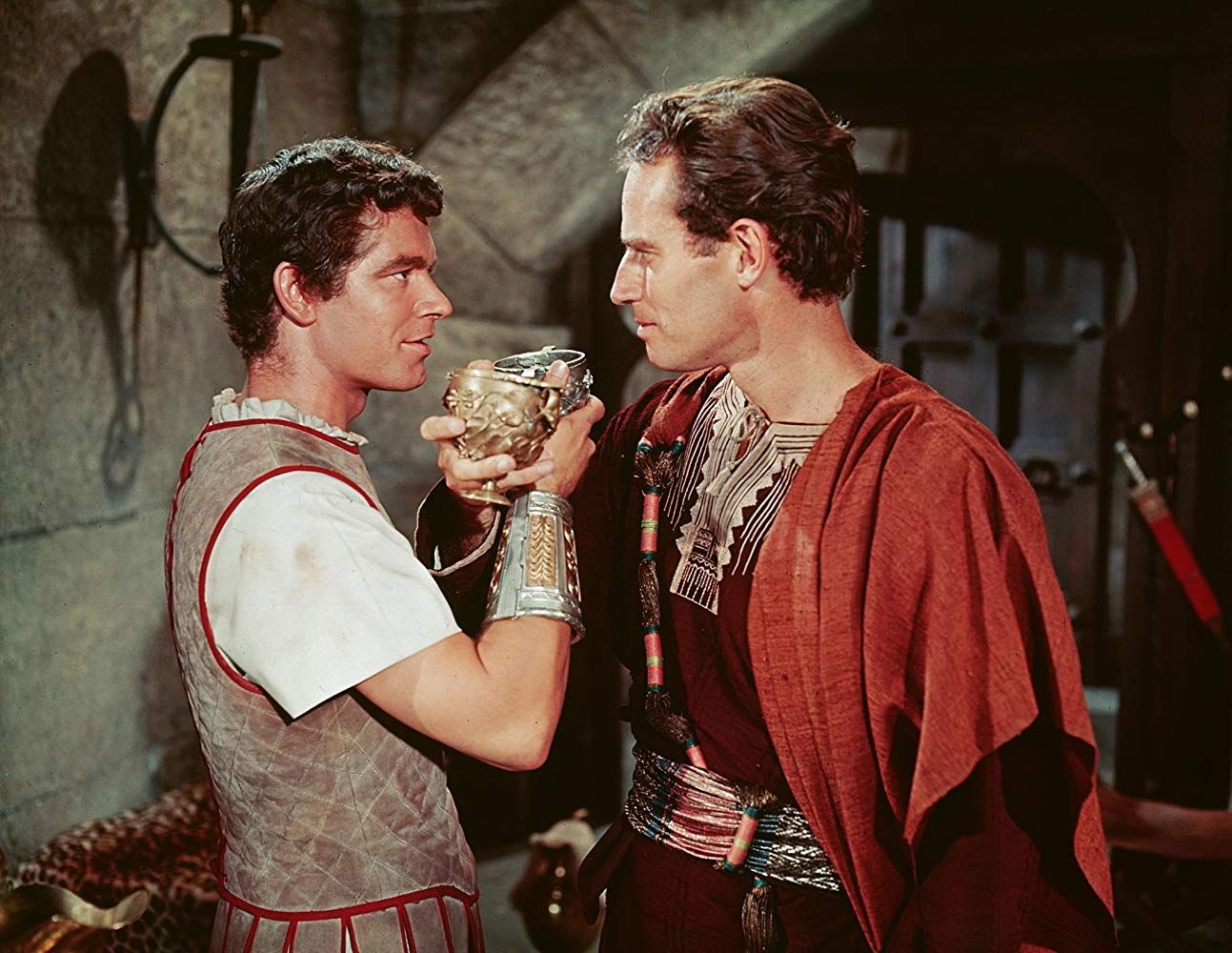
Its realization was no small feat, as is the case with many studio projects. MGM had intended to shoot a remake of the 1925 silent classic as early as 1954, two years after plans were announced. It had its eye on silent film director Sidney A. Franklin to helm the film, with Marlon Brando playing the title role. Things didn’t quite turn out that way. Karl Tunberg turned in an underwhelming script in 1955, prompting the studio to hire additional scribes for re-writes, Gore Vidal among them. Wyler came aboard in 1957 once the budget had ballooned to $10 million. He was promised $350,000 and a percentage of the box office gross, plus a chance to shoot in Rome. He couldn’t refuse. With Charlton Heston cast as the lead, the movie went to production in May of 1958.
The finished product—one that took nearly eight months to shoot, resulting in over one million feet of film—is a sight to behold. It tells you in its opening credits that it was shot on the MGM Camera 65, that is, an anamorphic lens producing a much wider aspect ratio than had been the norm until its introduction two years prior. Wyler and DP Robert Surtees took advantage of the extended scope as often as they could, capturing so much allure across the pastoral Italian countrysides and hills, and sets dressed up as first century Jerusalem, rendering the film a beautiful work of art. Of course, no sequence in the film is as breathtaking as the iconic chariot race, which occurs at the end of the second act. Even today it’s a marvelous achievement—technically, practically, physically.
As the cinema progressed technologically, practical effects diminished. Consider Ben-Hur’s crowd sequences as compared to that of, say, Gladiator. The former relied on the work of 1,500 extras (10,000 for the whole production). The latter digitally reproduced large swaths of its crowd to create the illusion of a Colosseum brimming with spectators. This, of course, is a common practice in the digital age, but in re-visiting old Hollywood, the appreciation value of the time and energy it took to film each sequence is exponentially higher. In Ben-Hur, what you see on screen is really there, with some exceptions of course, like painted mural backgrounds and early green screen technology, thanks to the work of special effects engineer Petro Vlahos.
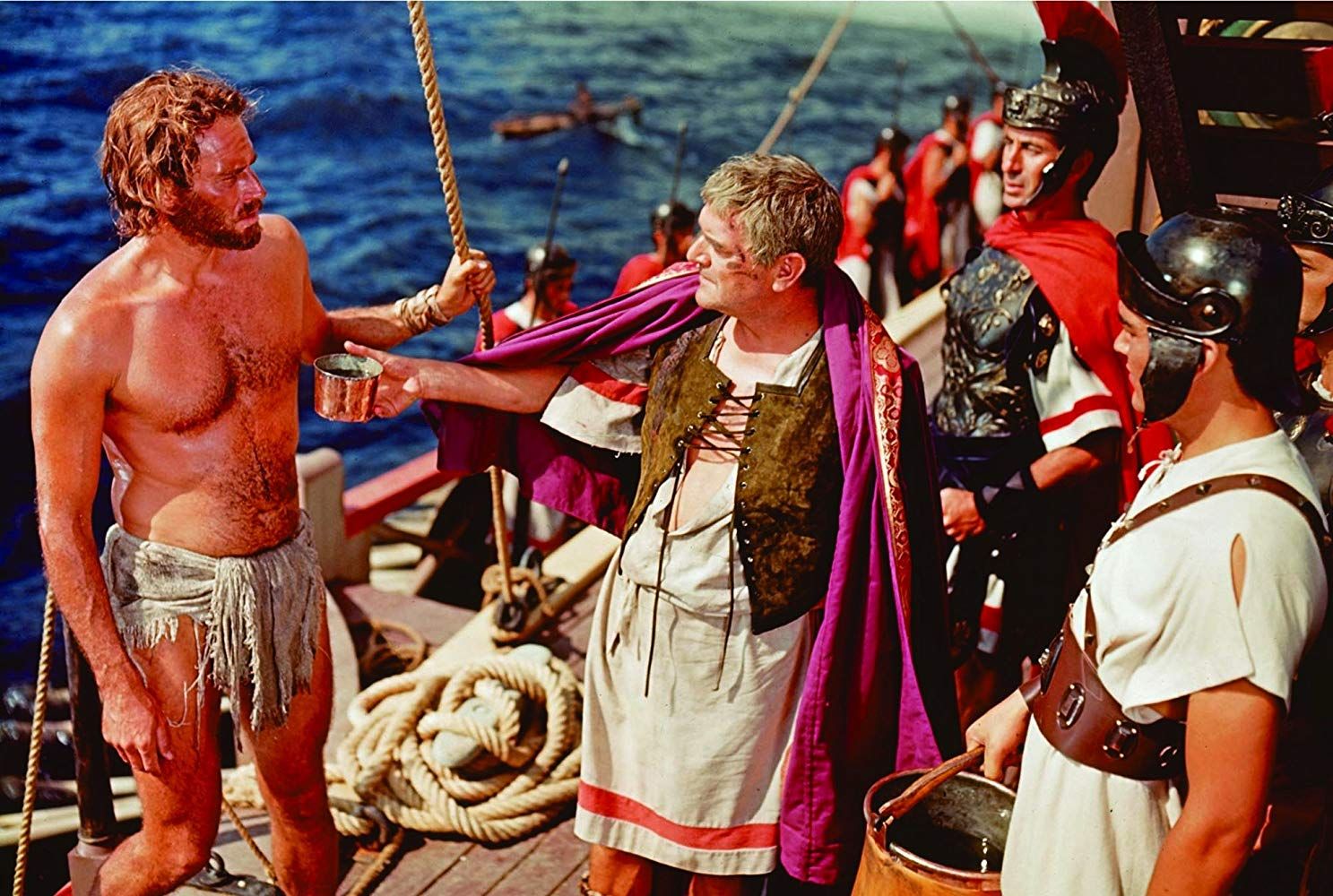
Like the vast majority of truly great movies, the element of Ben-Hur that resonates most deeply is the tale within its stimulating tableaus. Those opening titles once again tell us something important. As “Ben-Hur” dissolves, the next words we see on screen are these: “A Tale of the Christ, by General Lew Wallace.” Based on the Civil War general’s 1880 novel, Ben-Hur is indeed a Jesus movie. But a Jesus movie as told through the eyes of its first title character—Judah Ben-Hur. Perhaps it can be best described as the story of how Jesus changes Judah Ben-Hur. But it takes its time getting there (three and a half hours, remember). And in order to be changed, one must begin as—or become—someone in need of change. It’s this key ingredient that the film shares with so many character studies—before and after 1959. What separates this one is the reason for that change—the One who does the changing.
Call it what you want: faith-based, religious, Biblical. Studios don’t make them on the scale they once did. Even the biggest hit in the genre, The Passion of the Christ, was funded largely out of Mel Gibson’s own pockets. Some studios have faith-based labels, like Sony Pictures’ Affirm Films. Their shrewd business strategy is grounded in packaging their product as a wholesome alternative to mainstream material whose content is objectionable to some. But non-Christians simply don’t get out there to see those films, which are generally ham-fisted and preachy, as they elevate the message over the story, rather than the other way around. In 1959, when the most magnificent moviegoing experience you were going to find was a Bible picture, you went out to see it, regardless of your faith, or the faith of the people behind it. “It took a Jew to make a really good movie about Christ,” Wyler used to say.
Times have changed. Church attendance is down in the U.S., and the most powerful Hollywood executives have replaced the heroes of history with those from the pages of our comic books. The classics don’t find their way before fresh eyes. But they ought to, no rebooting or re-imagining necessary. At sixty, Ben-Hur still captivates. Its influence has been seen all over some of our favorite movies in the years since. A man of some status or privilege (Judah is a wealthy prince) is accused of something heinous and sent away to slavery, his thirst for vengeance fueling his survival. The aforementioned Gladiator uses this same concept as its basis. So did The Shawshank Redemption. And long, long before Ben-Hur, there was the Biblical story of Joseph in the book of Genesis. The favorite son of his father Abraham, Joseph is pummeled by his jealous brothers and left for dead. Enslaved in Egypt, the young dream interpreter eventually finds good favor with Pharaoh, is made the second most powerful man in the land, and ultimately comes face to face with his brothers years later (he forgives them). That story, and Alexandre Dumas’ The Count of Monte Cristo, undoubtedly influenced Wallace’s novel, though the endings of all these works vary greatly—that includes Wallace’s and Wyler’s versions of Ben-Hur.
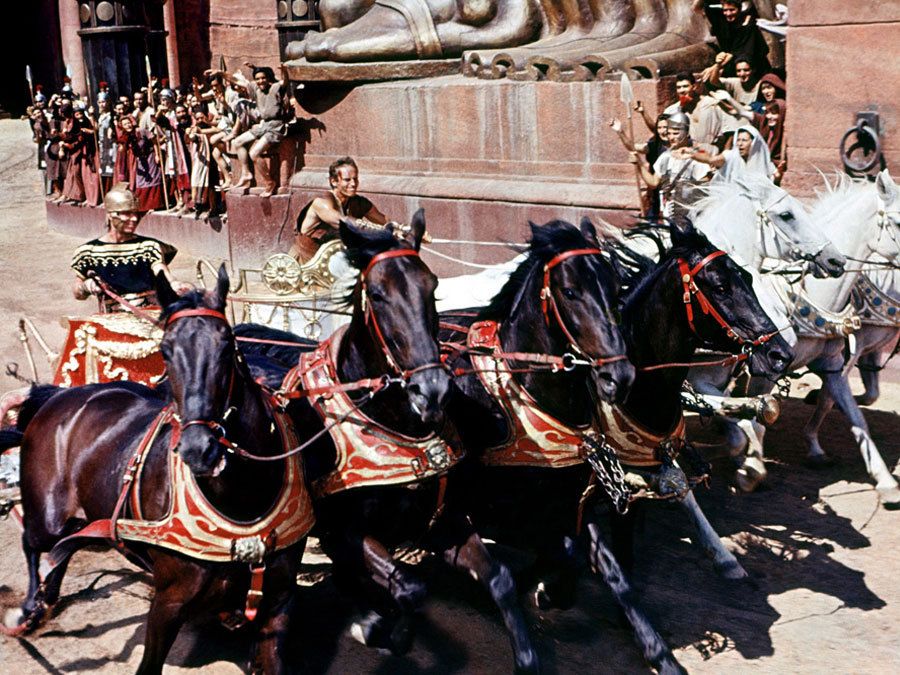
What all variations of it have in common—the novel, the 1925 silent film, the ’59 iteration, and the much maligned 2016 take—is the iconic chariot race. It’s worth spending time on because of its weight. This enthralling sequence is in the movie for so much more than the mere thrill of it. There’s so much riding on it. Everything is riding on it, one might say. The chariot race ought to serve as a lesson for up and coming storytellers on how to deliver high stakes action, because on par with the excitement are the emotional arcs of the characters involved. It’s been roughly five years since childhood friend Messala (Stephen Boyd), now a Roman tribune, sent Judah away into punishing slavery. He’s been starved in the desert, suffered in the galleys of a war ship, beaten, whipped, and treated as inhuman by Roman overlords. After escaping an enemy attack on the Mediterranean and saving his commander, Quintus Arrius (Jack Hawkins), when their ship is lost, Judah is hailed a hero. He’s a Jew embraced by Roman authorities, finding a new father-figure in Quintus. Again, the Joseph account comes to mind, or even the Moses story from Exodus. Even though life in Rome is far superior than the misery under its thumb, Judah has a sense of unfinished business within. He cannot let his hatred for Messala die, and the mystery of what happened to his mother and sister burdens him daily. He must get back to Jerusalem, must right these wrongs.
Judah is a man of principle. Messala had offered him the world in the first act. All Judah needed to do was align with him and help squash whatever Jewish uprising may have been brewing. But Judah puts his people over the comforts extended his way and, after an accident leads to an accusation of a threat against the Roman governor, the fates of Judah, his mother, and his sister, are all sealed. Even men of principle are flawed. Judah’s quest for vengeance is not a virtue, though we may understand it and hope he achieves it. So when he finally sees Messala in the flesh at Antioch, years of pent up rage is ready to burst forth. This is not simply a race; it’s an opportunity to scratch the most tormenting of itches. And it’s also a contest in which people will die. Messala has turned his chariot into a weapon. He aims to destroy the competition, quite literally, because what happens out on the track is fair game, so say the rules of these things. Nine times around they go, more and more drivers flipping out of their chariots, trampled to death by galloping steeds. It’s an intense scene that could not easily be faked. It cost more than $1 million alone, and took roughly five weeks to shoot. The circus at Antioch is a brilliant construction, and Wyler and Surtees give us so many angles of the deadly race—above, beside, within. Oftentimes, it’s evident that Heston and Boyd really are driving these horses themselves. In the end, it’s Messala that suffers mortal injuries, allowing Judah to come out on top, awarded a crown by none other than Pontius Pilate, the Roman governor of Judea.
What follows the race is the film’s most potent scene. Messala is tended to in some sort of an infirmary, though he won’t last long. One final meeting between he and Judah takes place. Looking at his old friend in anguish, Judah assures him that he no longer sees an enemy. But it’s Messala who will not let Judah win. Grabbing on to Judah, Messala informs him that the mother and sister he’d presumed were dead, are in fact alive… and they’re suffering as lepers. Messala delights in sharing this information. Every word is a struggle, but these ones taste sweet to his wicked soul. And with his last breaths, he utters this chilling taunt: “It goes on. It goes on, Judah. The race… the race is not over.”
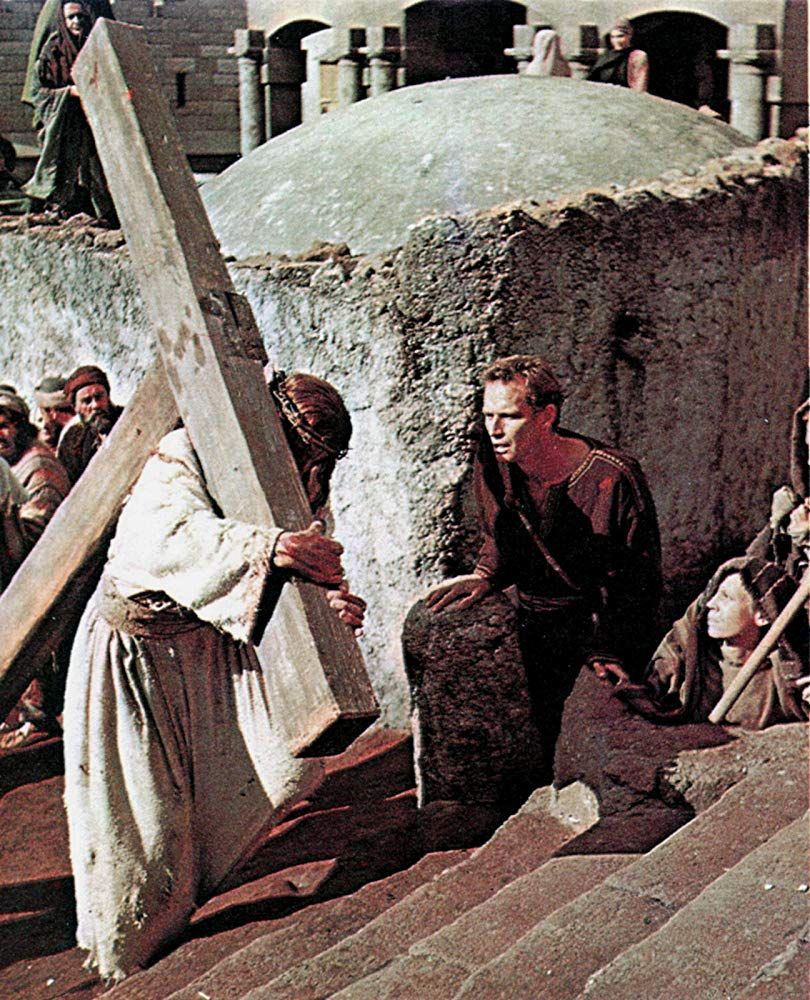
So you see, the action is elevated by the emotional stakes. It is earned. And the payoff is a gut punch. Judah has his vengeance, and still he is empty inside. Because the quest was never about vengeance; it was about healing. And here we find the crux—literally—of the whole thing. It’s the reason Wallace wrote the novel and titled it as he did. Anecdotally, Wallace himself would later claim he neither believed nor disbelieved the Bible’s claims. He was largely ignorant of them just a few short years before beginning research for the novel. And then something changed as he worked on it. “I found myself writing reverentially, and frequently with awe,” he said. From the chariot race to the conclusion, the novel and the film have a number of significant plot differences. Judah’s arc, however, remains the same. It’s at Golgotha’s cross where he recognizes his need for grace—for forgiveness. His mother and sister are made clean on the outside; Judah is washed of the leprosy of his heart.
Sixty years on, discussions surrounding Ben-Hur seem to touch on other matters, like Welsh actor Hugh Griffith in brownface as Sheik Ilderim. He would win Best Supporting Actor for the performance. Or the debate over whether or not Gore Vidal wrote the Judah/Messala relationship as a homosexual one. In 1995, he made that claim, suggesting he, Wyler, and Boyd were in on it, the latter being directed to play his role as a spurned lover. Heston would deny all of this, leading to a public spat between he and Vidal in 1996.
Controversies aside, Ben-Hur exists today as a memento, yet still a blueprint on how to tell an ambitious tale. It’s a big budget adventure and a character piece. It’s a Biblically reverent film and it’s aimed at a broad audience. And no, neither Ridley Scott’s Exodus: Gods and Kings nor Darren Aronofsky’s Noah meet this criteria. Western culture shifted. Technology evolved. Entertainment transformed. They don’t make ‘em like they used to because they can’t. Art reflects the time in which it is created, making the preservation of it so important. So long as it’s still accessible, we don’t need more movies like Ben-Hur; we already have them.






